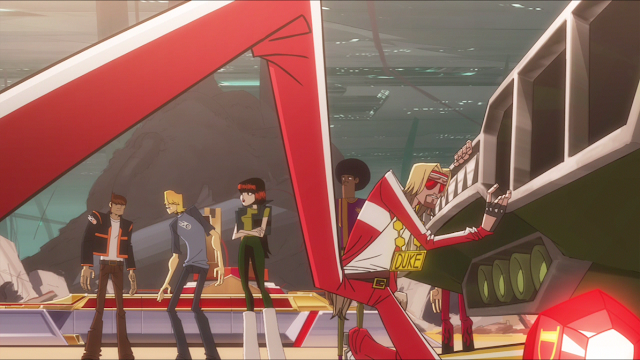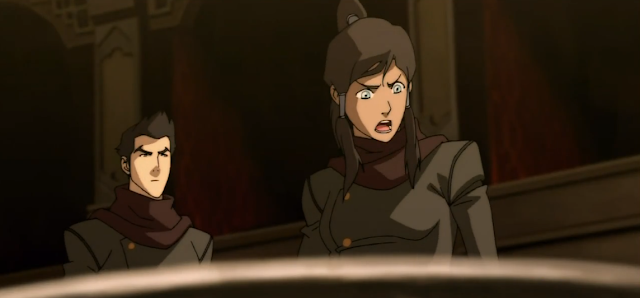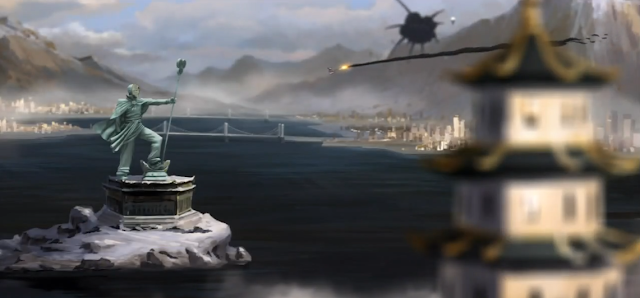 |
| "Oh please, Mike, don't drag me to see The Expendables 2! Stallone's plastic surgery scares me!" (Photo source: wait, was that slutty?) |
Two weeks ago, Disney XD accidentally leaked on iTunes a different Motorcity episode from the one that premiered that week ("Vendetta"). The channel corrected its mistake and immediately deleted from iTunes the incorrect episode, which I bought and before its removal, I had watched, thinking it was the episode that premiered on Disney XD the night before because DirecTV was temporarily inaccessible at my apartment that week. "Fearless" centers on the cowardice of Chuck, the conscience of the Burners team, as well as Mike's constantly whimpering hacker best friend, and I won't fully discuss "Fearless" until after Disney XD airs it, out of respect for the Disney/Titmouse show's staff, who have been reading this blog (thanks for the retweets!). Motorcity fans on Tumblr who caught "Fearless" on iTunes are also refraining from spoiling the episode for the same reason.
Disney XD is apparently airing episodes out of order on broadcast TV as well. Motorcity isn't a serialized show, but sometimes, the reshuffled episode order results in inconsistencies in character development like in the latest episode, "Blond Thunder." It was clearly produced before "Vendetta" because Mike is far less familiar with--and a little more irritated about--the quirks of the Duke of Detroit in "Blond Thunder" than in "Vendetta." Mike accidentally pisses off the Duke again, and this time, it's over car parts the Duke won't allow Mike to take from his junkyards without his permission.
 |
| (Photo source: wait, was that slutty?) |
If Chuck loses, Mike will hand over his cherished car Mutt to the Duke. If Chuck wins, the Burners get unlimited access to the Duke's junkyards. There's one problem: Chuck doesn't know how to drive, which he finally reveals to Mike, who promises to keep it a secret from the other Burners, and Chuck has only three days until the race to brush up on his driving.
Cars are outlawed in future Detroit, so Chuck's inability to drive is a common thing in the city, but he'd rather keep it a secret from his racer friends because he doesn't want to be ridiculed and ostracized by them, especially Texas, whom Chuck doesn't specifically mention. The jumpsuited and cocky Burner doesn't think much of Chuck, as we've seen in one of Texas' amusing fantasy sequences early in the show's run, and he'd probably want Chuck thrown off the team if he found out.
Texas' dislike of Chuck is understandable. He can be a grating character when his Cringer-from-He-Man-style mewling is turned up to 11 like in "Blond Thunder." At one point while training Chuck for the race, Mike asks him, "Is screaming really necessary?," and he responds with "It's my process!!" ("Fearless" also deals with Chuck's confidence issues but is a little more enjoyable than "Blond Thunder" because his whimpering is kept to a minimum, for reasons I can't wait to discuss when "Fearless" finally airs.)
After the Warriors-style hijinks of "The Duke of Detroit" and the intriguing pathos of "Vendetta," not much is at stake in "Blond Thunder," other than Mutt. But even when it's a low-stakes episode of Motorcity, the series never stops being visually inventive. "Blond Thunder" opens with a wonderful visual gag where a race that appears to be taking place on the Burners' test track turns out to be an R/C car race inside Jacob's kitchen. The competitions against the Duke's drivers may be a nightmare for Chuck, but for the rest of us, they're a stunningly animated feast for the eyes, like all the other action sequences on this show (they're not really as incomprehensible as some viewers have complained). Every cel on Motorcity is such a gorgeous work of art that I like to stare at one for a minute or two, via vidcap or freeze-frame. Let's do that now. I'll wait.
 |
| (Photo source: wait, was that slutty?) |
 |
| (Photo source: Clarke Snyder) |
 |
| (Photo source: wait, was that slutty?) |
***
I never understood why Racebending.com, a group of Asian American fans of Avatar: The Last Airbender that I first encountered face-to-face while attending a convention to take part in promoting the first Secret Identities graphic novel, was so protective of the original show during its protest of M. Night Shyamalan's much-maligned live-action adaptation and its whitewashed cast of heroes. The animated saga about superpowered martial arts dynamos who can control or "bend" either water, earth, fire, or air--the most powerful of these "benders" is known as the Avatar--always looked to me like another Firefly. In other words, it's another sci-fi or fantasy show set in an Asian milieu but with no major Asian characters, which makes about as much sense as Woody Allen's frequently black people-free vision of New York. So I never cared for the A:TLA franchise, which has been scoring huge ratings on Nickelodeon in its current incarnation, the sequel series The Legend of Korra.
Because of Korra's popularity, I've decided to cover its two-part season finale, "Skeletons in the Closet/Endgame," which meant I had to acquaint myself with the show. I went back and caught Korra's ninth and 10th episodes before viewing the finale and was surprised to discover that Dante Basco was voicing a descendant of a heroic character he played on A:TLA and a Korra character was named after Mako as a shout-out by creators Michael Dante DiMartino and Bryan Konietzko to the legendary actor, who worked on A:TLA before he died. So both A:TLA and Korra aren't completely colorless, although it's too bad the pro-bending athlete character who inherited Mako's name (and is voiced by Bud Bundy, of all people) is such an uninteresting douche. The title character (Janet Varney), a hotheaded and immature yet somehow still-likable heroine, deserves a better love interest.
 |
| (Photo source: lagunamov) |
One of the most enjoyable touches that DiMartino and Konietzko have added to Korra to distinguish it from A:TLA is the 1920s steampunk setting, which has resulted in rousing action sequences that pit the benders against machines, like the "Endgame" sequence in which Basco's General Iroh faces off against the Equalists' biplanes. Iroh's takedown of the pilots is badass even though it rehashes the old '80s G.I. Joe copout of showing defeated pilots parachuting to safety instead of falling or crashing to their deaths. (In the early '90s, Batman: The Animated Series temporarily carried on G.I. Joe's tradition of avoiding death with its scenes of thugs falling from Gotham City architecture and landing safely in the sea or on some sort of cushion, although by the time of B:TAS' "Off Balance" episode, the producers must have stopped caring about pleasing Fox's Standards & Practices and snuck in a terrorist double-suicide in "Off Balance.")
"Endgame" excels in the action and scoring departments (the luscious melodies and '20s jazz flourishes by A:TLA scoring veteran Jeremy Zuckerman recently received a thumbs up from Bear McCreary), but it falls short in its rushed resolutions to the intriguing non-bender-vs.-bender conflict that was established in the "Welcome to Republic City" premiere and Korra's depression over being deprived of her bending abilities by Amon's powers. The storyline about the non-bender movement's gripes with bender privilege in Republic City had the potential to bring some nuance to this kids' show, much like what Justice League Unlimited's Cadmus arc did to address and question the most right-wing aspects of the superhero genre. It's disappointing to see the conflict storyline go from ethical grayness to straightforward heroes-vs.-bad-guys beefing, as the A.V. Club's Emily Guendelsberger observed, and then unmask Amon as Noatak, a renegade waterbender who was using the non-bender movement to keep alive his bloodbending gangster father Yakone's scheme to kill the Avatar.
| (Photo source: lagunamov) |
Another gutsy moment on this show was the sight of the remorseful Tarrlok (Dee Bradley Baker) killing both himself and his brother Noatak on the motorboat in "Endgame." If Korra is willing to show a murder-suicide, then what was the point of G.I. Joeing all those Equalist pilots Iroh fireblasted out of their planes earlier? Are Nick toons only limited to two deaths per season?
***
God, Spider-Man's rogues gallery really pales in comparison to Batman's. I'll take psychotic comedians/showmen (Joker and Harley) and psychologically complex criminals (the B:TAS incarnation of Two-Face) over boring monsters like Venom and the current big-screen Amazing Spider-Man's Lizard any day. In the Man of Action-penned "Venomous" (not "Venom Attack," as reviews and TV listings have it titled), Ultimate Spider-Man rather unsatisfyingly wraps up its Venom arc, which started out with the great twist of the Venom symbiote that Norman Osborn (Steven Weber) invented going berserk and taking control of Norman's son Harry (Matt Lanter).
 |
| (Photo source: Marvel Animation Age) |
The decision to make Harry an unwilling and mostly unseen host for the creature instead of having Harry embrace his Venom form takes much of the bite out of this incarnation of Venom. Spidey's narration also continues to annoy, although in "Venomous," it's not the constant breaking of the fourth wall or the cutaway gags that are the most annoying parts of the narration. This time, it's Spidey's constant need to hold the younger viewers' hands by spelling out to them every plot point, like how he keeps reminding us that Harry is his best friend, more often than Keenen Ivory Wayans' old Arsenio Hall impression name-dropping his best friend Eddie Murphy on In Living Color.
***
At least the villains on The Avengers: Earth's Mightiest Heroes are far from dull. The ongoing Skrull conspiracy didn't just break up the Avengers and plant a mole into the team in the guise of Captain America (Brian Bloom). In "Nightmare in Red," the aliens have also deprived the massively downsized team of their primary muscle--Hulk (Fred Tatasciore)--by having him sent to prison for an attack on the S.H.I.E.L.D. helicarrier that he didn't commit, with the help of Red Hulk, the actual culprit and an evil version of Hulk who can release flames from his body; the Skrull duplicate of Captain America, who tells Hulk to turn himself in instead of fighting his arrest; and the original Cap's nemesis Red Skull (Steve Blum--again!), who's disguised as American politician "Dell Rusk."
The rarely seen Bruce Banner (voiced with an exhausted-drug-addict rasp by Gabriel Mann from ABC's Revenge) gets to be present for most of "Nightmare in Red" because the episode takes place on the one day of the month when Bruce's Hulk half allows the doctor to take an extended break from Hulking out. One of Earth's Mightiest Heroes' strong points is its revisionist take on Hulk, which this episode revisits (it feels like Hulk hasn't been on-screen for an eternity, or maybe it's just because of the strange mid-season hiatus Disney XD enforced on this show). In a nicely underplayed bit reminiscent of Mark Ruffalo's scenes as Bruce in Joss Whedon's The Avengers, although lacking in some of that Whedon-esque wit, Bruce chooses to go fishing on his day off (judging from his bizarrely empty and foodless motorboat, I guess there wasn't any time to pick up some shawarma) and takes along with him Clint Barton (Chris Cox), a.k.a. Hawkeye, who's too worried about the Skrulls and prefers the company of Hulk over Bruce.
 |
| (Photo source: Marvel Animation Age) |
 |
| (Photo source: Marvel Animation Age) |
***
My favorite animation voice guest shot of the week belongs to Donald Faison as the title character in "Princess Cookie," Adventure Time's latest short. The former Scrubs star's enjoyable role as a misunderstood and orphaned cookie who wants to be a princess like Bubblegum (Hynden Walch) despite what society tells him out-weirds anything J.D.'s overactive imagination ever dreamed up about Turk, including even that half-J.D./half-Turk creature straight out of the glubbed-up transporter in the Fly movies.
I also got a kick out of hearing the normal speaking voice of Maria Bamford, who's a frequent vocal presence on Adventure Time, instead of one of her various other voices. Here, Bamford turns up as the voice of Princess Cookie's accomplice Chipolina. (The reactions on Tumblr to "Princess Cookie" have been fascinating. They've ranged from teens who praise the episode and interpret it as a metaphor for either transgender people's struggles or at-risk youth to LGBT viewers who bristle at the portrayal of Princess Cookie as a violent and suicidal LGBT character. And then there are viewers who don't see sexual orientation or gender or race in Faison's character. They just see a cookie.)
Because Adventure Time is such an unpredictable ride, what starts out as a spoof of hostage-movie tropes--with Jake (John DiMaggio), the most laid-back hostage negotiator in screen history, talking Princess Cookie out of holding the Candy Kingdom citizens hostage inside a convenience store--morphs quite smoothly into one of the show's most affecting installments. Without having Jake spell things out to the screen like Spidey constantly does in the latest anvillicious Ultimate Spider-Man episode, "Princess Cookie" conveys a subtle message to the misfits in the audience that even though it feels like they're alone in the world, they won't be--whether they're teenage children of immigrants who don't want to be handcuffed to the boring careers that their strict parents have assigned to them or LGBT teens who refuse to be ostracized or mistreated by bullies or homophobic parents. Somewhere, there's a place where their misfit nature will be celebrated and embraced.







No comments:
Post a Comment